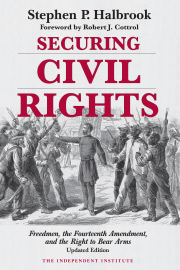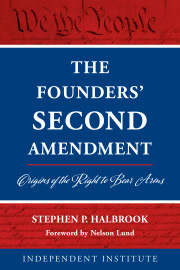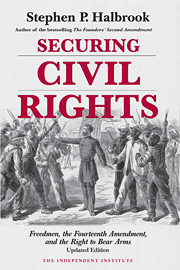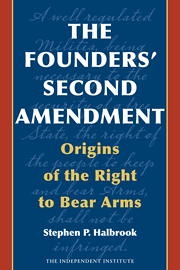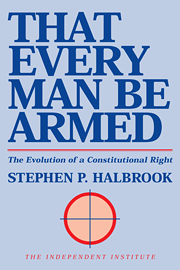Apprehending the snipers who recently terrorized the Washington area took place through old-fashioned gumshoe police work and citizen involvement. That did not, however, prevent the murders from sparking a new gun-control debate, this time over whether firearms should be “fingerprinted” through use of ballistic imaging.
The hijackers of Sept. 11, armed with box cutters and then with airliners, proved terrorists don’t need firearms. John Allen Muhammad and John Lee Malvo were vocal sympathizers of the hijackers. Muhammad told Harjeet Singh that he planned to shoot a fuel tanker and cause it to explode on the freeway, and then to snipe at motorists. He also intended to kill a police officer and then blow up the mourners at the funeral home. Last June, Singh disclosed these conversations to police and an FBI agent, who did nothing.
Media discussion highlights that Muhammad had been in the U.S. military and had rifle training, and that the great satan—the National Rifle Association (NRA)—has blocked “commonsense” gun legislation. Muhammad’s terrorist sympathies and plans are barely mentioned.
During the same period that the snipers played their deadly game, drug traffickers firebombed the Baltimore row house of a neighborhood antidrug activist, killing her, her husband and her five children. These murders prompted zero legislative panaceas.
But, for those focused on the single-minded agenda of regulating American citizens who own firearms, the serial sniper rejuvenated S 3096, the Ballistics, Law Assistance and Safety Technology Act, sponsored by Sens. Herb Kohl (D-Wis.), Dianne Feinstein (D-Calif.), Charles Schumer (D-N.Y.) and Jack Reed (D-R.I.); and HR 408, sponsored by Reps. Anna Eshoo (D-Calif.) and John Conyers (D-Mich.). This legislation would require ballistics testing of all firearms manufactured.
The bills would require manufacturers and importers to test-fire all firearms, prepare ballistics images of the bullets and cartridge casings (which must then be stored) and provide the records to the Bureau of Alcohol, Tobacco and Firearms (ATF) for its computerized database which law-enforcement agencies can access. Agencies will work with industry “to curb firearm-related crime and illegal firearm trafficking.” The bills allocate $20 million to get things started.
The bills end with an unlikely section entitled “Privacy Rights of Law Abiding Citizens,” which provides that ballistics information “may not be used for prosecutorial purposes unless law-enforcement officials have a reasonable belief that a crime has been committed and that ballistics information would assist in the investigation of that crime.” Indeed not, prosecutions cannot proceed without probable cause to believe these things. This does not restrict surveillance of law-abiding citizens where no prosecution has been initiated.
The scheme is a giant loophole if it does not include the names of the current owners of the 260 million firearms already out there, who must bring their guns in for testing. To be enforceable, felony penalties must be imposed for noncompliance. The gun owners may as well be fingerprinted and photographed while they’re at it—the lack of which is just another loophole. Would criminals, after they obtain their guns through theft or the black market, keep ATF current with their names, addresses and gun descriptions?
Technically, the proposal just isn’t feasible as a crime-fighting tool. Fingerprints and DNA do not change, but bullets and shell casings certainly do. Rifling marks on a bullet change as the barrel receives more wear and tear—a couple of scrapes with a file can change the “fingerprint” immediately—and barrels may easily be replaced. Shell-casing marks are made by the breech face or bolt, extractor, ejector and firing pin. Again, a swipe with a file, normal wear or parts replacement creates a new “fingerprint.” Ammunition made by different manufacturers give dissimilar images. Shotguns shoot ball shot through a smooth bore, so there’s no bullet to test; revolvers and single-shot rifles leave no ejection marks. Only semiautomatics eject shell casings, but a brass catcher can be attached. A criminal could leave someone else’s fired brass (perhaps from a shooting range) at a crime scene.
To be sure, ballistics testing can be useful on a limited basis to help solve crimes, chiefly when a crime gun is seized. A shell casing from the seized firearm may be compared with a casing from the scene of an unsolved crime. After a close match is found through use of the database, an examiner then must make visual comparisons using optical devices. By limiting the database to crime guns, the evidence is pinpointed, and the system is not overloaded with images of casings from countless firearms held by the public at large. The National Integrated Ballistic Information Network (NIBIN), administered by the ATF, conducts this type of testing.
The Bureau of Forensic Services of the California Department of Justice conducted tests and concluded: “When applying this technology to the concept of mass sampling of manufactured firearms, a huge inventory of potential candidates will be generated for manual review. This study indicates that this number of candidate cases will be so large as to be impractical and likely will create logistic complications so great that they can not be effectively addressed.” A database of shell casings from all firearms would generate so many "hits" that the information would be useless.
The Ballistic Imaging Evaluation and Study Act (HR 3941 and S 2581), sponsored in the U.S. House of Representatives by Republican Rep. Melissa Hart of Pennsylvania and in the Senate by Democratic Sen. Zell Miller of Georgia, would provide for further study by the National Academy of Sciences. The bills are supported by the NRA and the National Shooting Sports Foundation.
Maryland and New York are the only states which require ballistic imaging for all new handguns sold in those states. Neither has solved a single crime with these programs. After defunding programs that put cops on the beat, Maryland spent $5 million to test 2000 handgun shell casings. As the sniper struck in the D.C. suburbs, the FBI disclosed that Maryland had halted certain background checks on gun buyers because funds had run out.
When the sniper was on the loose, we saw an illustration of how police are spread too thin when every citizen is a suspect. While cops halted all traffic to search white vans, ATF went into every gun store in the Maryland suburbs and got the identity of every purchaser of a .223-caliber rifle. Cops then beat on the doors of every such person—there were hundreds—and seized the rifles for ballistic testing. All the while the sniper cruised around in his blue Chevy Caprice sedan with his rifle purchased on the West Coast.
While current bills in Congress would require ballistic testing only of new guns, the system would be worthless without testing of all guns and registration of all gun owners. Any transfer of a gun would require notice to ATF. The replacement of any parts, whether a barrel or firing pin, would necessitate new ballistic testing. Thus, the sale of firearm replacement parts would need to be regulated—they would need serial numbers and would require an ATF permit to acquire. New crimes with new felony penalties must be legislated.
The above is not a slippery-slope prediction; rather it is the only logical path of the current push for governmental omniscience regarding gun owners. Every new control has inherent “loopholes” allowing “circumvention,” and these defects will continue until perfect knowledge by the authorities is attained. Gun controllers insist that knowing who owns every gun and the fingerprints of every gun would have led police immediately to Muhammad. As claimed by the Brady Campaign to Prevent Gun Violence, ballistic fingerprinting would have [solved this crime after the first shooting.”
Yet, in all but one of the shootings, no shell casing was found since Muhammad and/or Malvo were shooting from inside a car trunk, where there were openings for the barrel and the scope. The casings were ejected into the trunk. Perhaps the Brady group will suggest a further panacea—making it illegal to shoot from car trunks.
While prohibitionist groups deny that ballistic-fingerprinting programs would require registration of firearm owners, they simultaneously are calling for bans on ordinary rifles. More typically—as experiences from Nazi Germany to current England and New York City verify—registration is enacted first, and then confiscation. Today’s approach is more direct: “Tougher restrictions must be placed on so-called sniper rifles, such as the .50, .308 and .223 calibers,” says Tom Diaz of the Violence Policy Center. Rep. John Conyers (D-Mich.) urges the Federal Trade Commission to investigate the marketing of rifles to civilians, arguing that “Sniper weapons are different from standard hunting rifles because they are designed to strike a target from a distance.”
Factually, the .308 is a “high-caliber” rifle that hunters typically equip with a scope to strike deer “from a distance.” The .223 rifle is the most popular caliber for varmint hunting. “Sniper” rifle is a pejorative substitute for “hunting” rifle.
Since only one shot was fired in each of the D.C. area murders, the murder weapon could have just as well been a single-shot. In fact it was a Bushmaster XM15 semiautomatic. Contrary to media reports, that rifle is not an “assault weapon” as defined by federal law. Yet prohibitionists already are appealing to the recent killing spree to argue for reenactment of the federal assault-weapon ban which sunsets in 2004.
The proposal for universal ballistic fingerprinting is just one more scheme to register, regulate and potentially incarcerate law-abiding firearm owners. It offers no true benefit for law enforcement—as the Fraternal Order of Police puts it: “With such small chances that it would be used to solve a firearm crime . . . these are law-enforcement dollars best spent elsewhere.” Instead of pinpointing likely suspects, it overextends the net and makes a suspect out of every American citizen who chooses to own a firearm.
Does the United States Need a National Database for Ballistic Fingerprints?
No: Don’t Start a Boondoggle Bullet Library that Will Become a Stealth Gun Registry
Also published in Insight Magazine
Stephen P. Halbrook is a Senior Fellow at the Independent Institute and author of the Independent books The Right to Bear Arms, Gun Control in Nazi-Occupied France, Gun Control in the Third Reich, The Founders’ Second Amendment and That Every Man Be Armed.
Bureaucracy and GovernmentCivil Liberties and Human RightsConstitutional LawCrime, Criminal Justice, and PrisonsDefense and Foreign PolicyGovernment and PoliticsGun ControlLaw and LibertyRegulationTerrorism and Homeland Security
Comments
Before posting, please read our Comment Policy.



